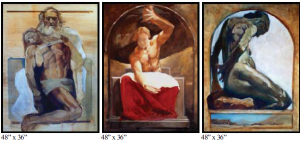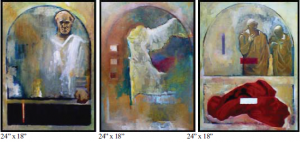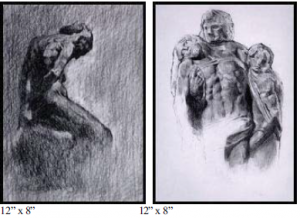Jared Miller, Victor Ludlow (Ancient Scripture) and Jason Zimmer (Visual Arts)
Jared Miller A Pictorial Perspective of Isaiah Faculty Mentors: Victor Ludlow, Ancient Scripture and Jason Zimmer, Visual Arts Taking a pictorial perspective of Isaiah, and glimpsing the visions of his painted poetry had always seemed to personally open a window of understanding to his words and prophecies. Therefore this project focuses on taking Isaiah, his messianic message, his own persona, and prophecies and expressing them visually, that “[we might more clearly] with [our] eyes… and understand with [our] hearts and be converted and healed” (Isaiah 6:10).
In studying the words of Isaiah, the concepts and layered imagery became so complex that in putting them on paper or canvas the visual imagery became overburdened—the impact of the picture lost. This problematic iconographical melee was resolved as a more narrow focus was taken with Isaiah’s words.
Yet, while eliminating peripheral concepts, the project itself grew from its original plan of one painting and six studies to a total of sixteen pieces (eight paintings, 1 lithograph, seven charcoal studies).
Two of the major paintings (48” x 36”) deal specifically with Christ’s sacrifice, while eleven of the other pieces are juxtaposed thematically to the atonement of Christ.
The first of the two major works moves on a direct level. Centered in the picture is the dead Christ held in the arms of his Heavenly Father showing to the viewer the condescension of Christ and the personal sacrifice of our Father. Taken from Isaiah 53, the painting explains how “it pleased the Lord to bruise him…[to] put him to grief… [to] make his soul an offering for sin….for he shall bear [our] iniquities,” for “with his stripes we are healed” (Isaiah 53:10-11,5).
As Isaiah’s prophecies worked on different levels to different people, so too does the second painting work on separate levels. The main focus is on Isaiah’s prophecies on Christ and his atonement. The second level meanwhile deals with Isaiah the prophet and his writings and their relationship with the reader.
The central figure, Christ, is draped in a crimson cloak and wearing a white apron, softly glowing in light. While sitting upon the judgement seat he reaches out waiting for the viewer to take his outstretched hand. Yet while his hand is “outstretched still” he bears upon his back the burden of the atonement in the image of a giant rock.
The figure dually represents Isaiah. The “burden” he carries are the truths and visions “which Isaiah the son of Amoz did see” (Isaiah 13:1). His call from the Lord is also depicted by a piece of glowing coal above the figure and a man’s lips placed below revealing his divine calling as mouthpiece of the Lord (see Isaiah 6).
Contextual reference material for the project stemmed directly from the book of Isaiah or from Dr. Victor Ludlow’s book Isaiah: Prophet, Seer, and Poet, while the visual reference came from works by the old masters, or personal reference material. Despite these references the paintings themselves went through several stages of change with the coming of new understanding or a changed perspective.
While four of the pieces were exhibited in a Salt Lake show earlier this spring, the full show will be held in the B. F. Larsen Gallery (in the Harris Fine Arts Center on BYU’s campus) from November 18-28. Presently 11 of the 16 pieces are either completed or near completion, while the other five are at more intermediate stages. Some of the works will also be placed online. Titles and in-depth explanations will accompany each piece at the show.




